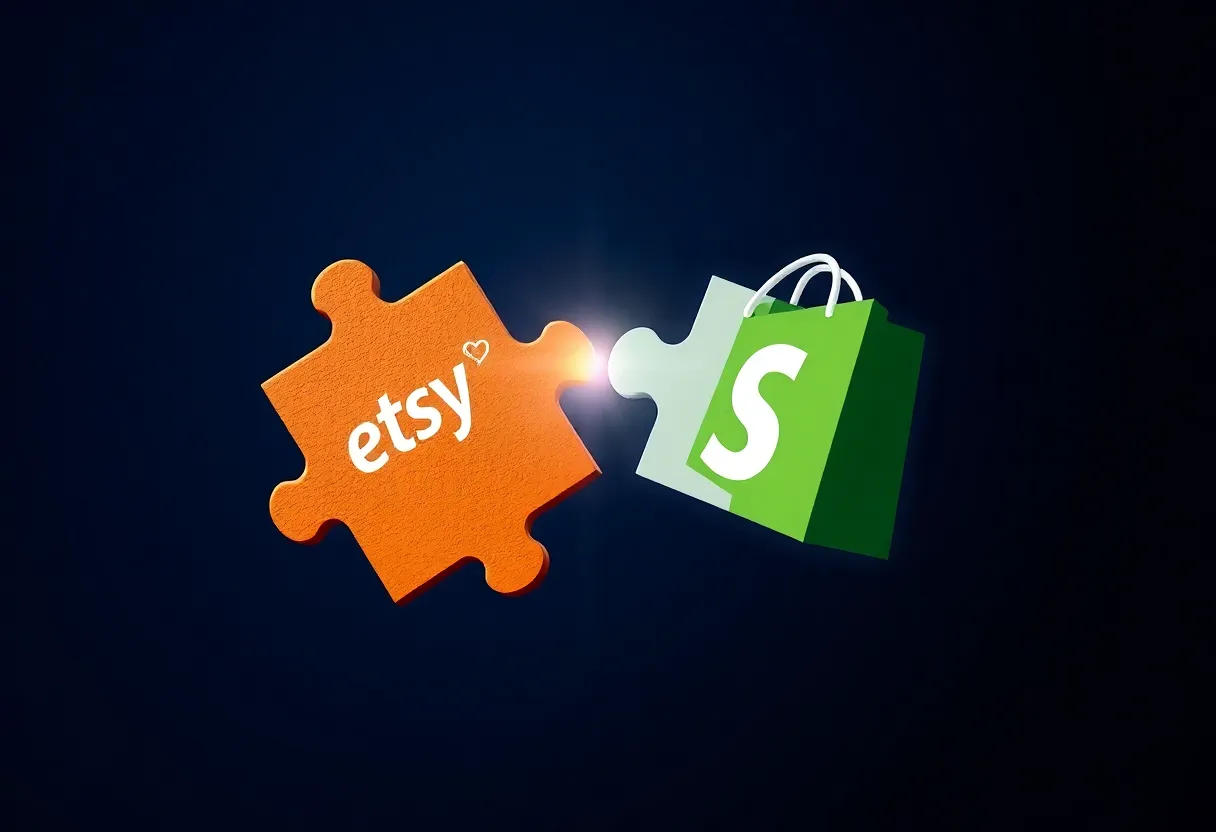Table of Contents
The E-commerce Landscape
Online selling has exploded in recent years, with global e-commerce sales reaching a staggering $4.9 trillion in 2021. Two major players in this space are Etsy and Shopify, each catering to different seller needs.
Etsy has carved out a unique niche in the handmade and vintage goods market. With over 7.5 million active sellers, Etsy attracts creative entrepreneurs looking to share their crafts with a global audience. The platform’s user-friendly interface and built-in customer base make it an attractive option for artisans and small businesses.
On the other hand, Shopify powers over 1.7 million businesses worldwide, offering a versatile e-commerce solution for sellers of all sizes. Its robust features allow merchants to create custom online stores, manage inventory, and process payments seamlessly.
- Etsy strengths:
- Ready-made marketplace
- Strong community of craft enthusiasts
- Lower barrier to entry for new sellers
- Shopify advantages:
- Full control over store design and branding
- Extensive app ecosystem for customization
- Multi-channel selling capabilities
While both platforms offer unique benefits, many sellers are discovering the power of combining Etsy and Shopify to maximize their reach and efficiency. This integration allows businesses to tap into Etsy’s established marketplace while leveraging Shopify’s advanced e-commerce tools.
For those looking to expand their online presence, connecting multiple marketplaces can be a game-changer. Tools like Marketplace Connect simplify this process by automating order syncing and inventory updates across platforms, including bol.com and Shopify integration.
This video offers valuable insights for new Etsy sellers looking to boost their sales and visibility on the platform. It provides practical tips that can help sellers make the most of Etsy’s marketplace while considering how to expand their e-commerce presence.
| Platform | Active Sellers | Annual Sales |
|---|---|---|
| Etsy | 7.5 million | $13.5 billion (2021) |
| Shopify | 1.7 million | $175.4 billion (2021) |
As the e-commerce landscape continues to evolve, sellers are finding innovative ways to combine the strengths of different platforms. By understanding the unique features of Etsy and Shopify, businesses can create a powerful online presence that reaches more customers and drives growth.
Setting Up Etsy-Shopify Integration
Getting your Etsy and Shopify stores to work together can be a game-changer for your online business. The first step is picking the right integration tool. You’ll want something that’s easy to use but powerful enough to handle all your needs.
Once you’ve chosen your app, it’s time to connect your accounts. This usually involves logging into both Etsy and Shopify and giving the app permission to access your store data. Don’t worry – reputable apps use secure methods to protect your information.
- Choose a reliable integration app
- Connect your Etsy and Shopify accounts
- Sync your existing products and inventory
After setup, you’ll need to sync your products. This process pulls all your Etsy listings into Shopify (or vice versa). It’s a good idea to double-check that everything transferred correctly, especially prices and descriptions.
This video offers some great tips on boosting your Shopify sales, which can be helpful as you integrate with Etsy:
Managing Inventory Across Platforms
One of the biggest challenges of selling on multiple platforms is keeping your inventory straight. Nobody wants to oversell and disappoint customers. That’s where real-time inventory syncing comes in handy.
- Set up automatic inventory updates
- Decide how to handle product variations
- Create a buffer stock for popular items
When you’re dealing with product variations (like different sizes or colors), make sure your integration app can handle them correctly. Some apps might treat each variation as a separate product, while others can manage them as a single listing with options.
- Use real-time syncing to prevent overselling
- Regularly check for any sync errors or mismatches
- Consider using a central inventory management system
Preventing stockouts is crucial for maintaining good customer relationships. Some sellers keep a small buffer stock for their most popular items. This can give you a bit of breathing room if there’s a sudden spike in sales on one platform.
Streamlining Order Fulfillment
Efficient order processing is key to keeping your customers happy and your business running smoothly. When you’re selling on both Etsy and Shopify, having a centralized order management system can save you tons of time.
| Task | Manual Process | With Integration |
|---|---|---|
| Order Processing | Check multiple platforms | All orders in one place |
| Shipping Updates | Update each platform separately | Automatic syncing |
| Inventory Adjustments | Manual updates on each site | Real-time syncing |
Automating shipping and tracking updates is another big time-saver. When you mark an order as shipped in one system, a good integration app will update the status across all your sales channels. This keeps your customers in the loop without any extra work on your part.
Handling returns and customer service can get tricky when you’re on multiple platforms. It’s important to have a clear system for managing these issues. Some sellers use a separate customer service tool that integrates with both Etsy and Shopify to keep everything organized.
By the way, if you’re looking for a tool to help with all this, our Marketplace Connect app handles many of these tasks automatically. It’s designed to make multi-channel selling easier, whether you’re connecting Shopify with Etsy, bol.com, or other marketplaces.
Remember, the goal of integrating your Etsy and Shopify stores is to simplify your workflow and grow your business. With the right tools and strategies, you can reach more customers and boost your sales without doubling your workload.
Maximizing Sales Potential
Integrating Etsy with Shopify opens up a world of opportunities for online sellers. By connecting these platforms, businesses can tap into Etsy’s creative marketplace while leveraging Shopify’s robust e-commerce tools. Let’s dive into how this integration can supercharge your sales strategy.
One of the key advantages of this integration is the ability to analyze cross-platform sales data. This insight allows sellers to:
- Identify top-performing products across both platforms
- Understand customer preferences on each marketplace
- Spot trends and seasonal patterns
- Adjust inventory levels based on demand
Armed with this data, sellers can make informed decisions about pricing and promotions. Dynamic pricing strategies become possible when you can easily compare performance across platforms. Consider these tactics:
- Test different price points on each platform
- Offer platform-specific discounts to boost sales
- Bundle products differently based on platform preferences
Expanding your product offerings strategically is another benefit of Etsy-Shopify integration. By analyzing which products resonate on each platform, you can:
- Tailor your inventory to each marketplace’s audience
- Introduce new product lines based on cross-platform insights
- Optimize product descriptions and tags for better visibility
Managing multiple sales channels can be challenging, but tools like Marketplace Connect simplify the process by automating order syncing and inventory updates. This efficiency allows you to focus on growing your business instead of juggling manual updates.
Leveraging customer reviews from both platforms can also boost your credibility and sales. Consider showcasing your best Etsy reviews on your Shopify store to build trust with new customers.
By integrating Etsy with Shopify and using the right tools, sellers can create a seamless multi-channel experience that maximizes sales potential and reaches a wider audience. Whether you’re looking to expand your Etsy business to Shopify or vice versa, the key is to use data-driven insights to inform your strategy and streamline your operations.
Wrap-up Your Multi-Channel Success
Integrating Etsy and Shopify can really boost your online sales. It’s not just about being on more platforms – it’s about working smarter, not harder. By connecting these channels, you can manage everything from one place, save time, and focus on growing your business.
Getting started is pretty straightforward. You’ll need a tool that links Shopify to marketplaces like Etsy and bol.com. Our Marketplace Connect app does this, syncing orders and inventory automatically. It’s priced from $19.99 per month, with a free trial to test it out.
Looking ahead, think about expanding to even more sales channels. The more places you sell, the more customers you can reach. Just make sure you have a system that can keep up. With the right setup, you can turn multi-channel selling from a headache into a major advantage for your business.
Ready to take the next step? Check out the FAQ section below for more details on getting started with Etsy and Shopify integration. And remember, the key to success is finding tools that grow with your business.
Learn more about streamlining your multi-channel sales: Marketplace Connect on Shopify
Common Questions About Etsy-Shopify Integration
How much does it cost to integrate Etsy with Shopify?
The cost varies depending on the integration method you choose. Some apps like Marketplace Connect start at $19.99 per month and offer free trials. Native Shopify integrations may have different pricing structures. It’s best to compare options to find the most cost-effective solution for your business needs.
What technical skills do I need for Etsy-Shopify integration?
Most integration apps are designed to be user-friendly, requiring minimal technical expertise. Basic familiarity with Shopify and Etsy platforms is helpful. If you’re comfortable managing your online store, you should be able to handle the integration process with the right tools.
Can I sync inventory between Etsy and Shopify?
Yes, inventory syncing is a key feature of most Etsy-Shopify integration tools. This allows you to manage your stock levels across both platforms from a single dashboard, reducing the risk of overselling. Our Marketplace Connect app, for example, offers real-time inventory updates across multiple channels.
What are common issues with Etsy-Shopify integration?
Common challenges include initial setup complexities, occasional sync delays, and ensuring proper product data mapping. Most issues can be resolved by carefully following setup instructions, regularly checking sync status, and reaching out to support teams when needed.
How does Etsy-Shopify integration handle order processing?
Integration tools typically centralize order management, allowing you to process Etsy orders directly from your Shopify dashboard. This streamlines workflows, reducing manual data entry and the potential for errors. Some apps also offer automated order syncing to keep both platforms updated in real-time.
Can I connect other marketplaces besides Etsy to Shopify?
Absolutely. Many integration solutions support multiple marketplaces. For instance, Marketplace Connect allows you to link Shopify with various platforms like Amazon, bol.com, and more, in addition to Etsy. This multi-channel approach can significantly expand your reach and simplify management across different sales channels.





